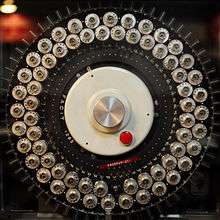FACIT EDB
FACIT EDB was a vacuum tube based computer that was manufactured by Åtvidabergs Industrier AB after the designs for BESK, that had been developed by the Swedish Board for Computing Machinery (Matematikmaskinnämnden).

FACIT EDB was the first fully Swedish series production computer. EDB stod for "Electronic Computer Processing". The manufacturing was done by Åtvidabergs Industrier department of electronics in Stockholm and came to fruition by recruiting 18 key persons from the Swedish Board for Computing Machinery (Matematikmaskinnämndens). Internally nicknamed "the Besk boys". In 1960 the department became Facit Electronics with a new factory in Solna. The recruitment of people from Swedish Board for Computing Machinery were approved by the Finance minister Gunnar Sträng. That thought that production of computers was not something the government should be involved in.[1] In 1963 a FACIT EDB-3 was installed at National Defence Radio Establishment (FRA) which enabled use at any time of the day.[2]
History
In 1956 Åtvidabergs industrier recruited seventeen people from the Swedish Board for Computing Machinery that had developed the BESK computer. The same year the company bought the designs drawings for BESK and the first copy were inaugurated in October 1957. It had some improvements, like the double amount of magnetic-core memory, later came a new advanced magnetic tape memory, the carousel memory.
FACIT EDB was installed as a service machine in Åtvidaberg industries facilities at Karlavägen in Stockholm. It meant that customers could come and run their own programs for payment per the hour. The machine became heavily used, the need for calculations existed among others in meteorology.
Operation
FACIT EDB were like the BESK computer a so called IAS machine. The original IAS-machine were completed at Massachusetts Institute of Technology (MIT) in 1951. FACIT EDB were programmed by loading a program into the working memory, were also in- and output data could be stored. IAS-machines weren't software compatible, but build on drawings of the original IAS-machine architecture.
FACIT EDB was a copy of the BESK, and was built with a combination of electron tubes and germanium diodes. The programs were fitted with break points so that the calculation could be resumed after som electron tube had burnt out and been replaced. As working memory a ferrite core was used.
Input- and output units were:
- Paper tape reader (in) 500-1000 characters/second. 5-8 channel strip.
- Magnetic tape, carousel memory from 1958, (in and out)
- Typewriter (out) circa 10 characters/second.
- Paper tape puncher (out) circa 150 characters/second.
- Teleprinter (out) 11 rows/second, 160 characters/row.
- Control panel (in and out).
Software and programs for the machine was among others an ALGOL compiler, machine code compiler and operating system. The machine could also run various standard programs meant for BESK.
References
Hallberg, Tord-Jöran (2007). IT-gryning: svensk datahistoria från 1840- till 1960-talet [Dawn of IT: Swedish computer history from the 1840s to the 1960s] (in Swedish). Lund: Studentlitteratur. ISBN 978-91-44-03501-7. libris=10358983.
- Tord Jöran Hallberg (2007), Tidig svensk datahistoria [Early Swedish computer history] (in Swedish), Google translation, Centrum för Näringslivshistorias tidning Företagsminnen 2007:2,
första exemplaret av nio av den första serietillverkade helsvenska datorn, Facit EDB, där EDB stod för elektronisk databehandling. Den tillverkades av Åtvidabergs Industriers Elektronikavdelning, som höll till i Stockholm och bildades genom värvning av 18 av Matematikmaskinnämndens nyckelpersoner, internet kallade "the Besk boys". Avdelningen blev 1960 Facit Electronics med ny fabrik i Solna. Åtvidabergs Industrier var vid den här tiden mycket stora i kontorsmaskinbranschen, även internationellt, med tillverkning av mekaniska räknemaskiner, skrivmaskiner m.m. Övertagandet av Matematikmaskinnämndens personal godtogs av finansminister Gunnar Sträng, som tydligen tyckte att det inte var statens sak att tillverka datorer.
(HTML 12 kB) - Ulf Bjälkefors (2012-06-15), Min IT-verksamhet åren 1960-1980 [My activity in IT between the years 1960-1980] (PDF) (in Swedish), tekniskamuseet.se, archived from the original (PDF) on 2016-04-05, retrieved 2016-03-25,
1963 installerades en BESK-kopia (Facit EDB-3) vid FRA och dänned hade vi tillgång till maskinresurserna både dagar och nätter. Facit-maskinen hade dessutom hålkortsläsare och hålkortstans som in- och utorgan
(PDF 3379 kB)
External links
- kth.diva-portal.org: Att arbeta med 1950-talets matematikmaskiner: Transkript av ett vittnesseminarium vid Tekniska museet i Stockholm den 12 september 2005 (English: to work with 1950s mathematical machines: Transcript of a witness seminar at Museum of Technology in Stockholm)
- tekniskamuseet.se: Datorer och program för kristallografiska beräkningar 1950-1980, minnesberättelse av Rune Liminga och Ivar Olovsson, 2011 (English: computers and programs for calculations on crystallography 1950-1980, a memory tale by Rune Liminga and Ivar Olovsson, 2011)